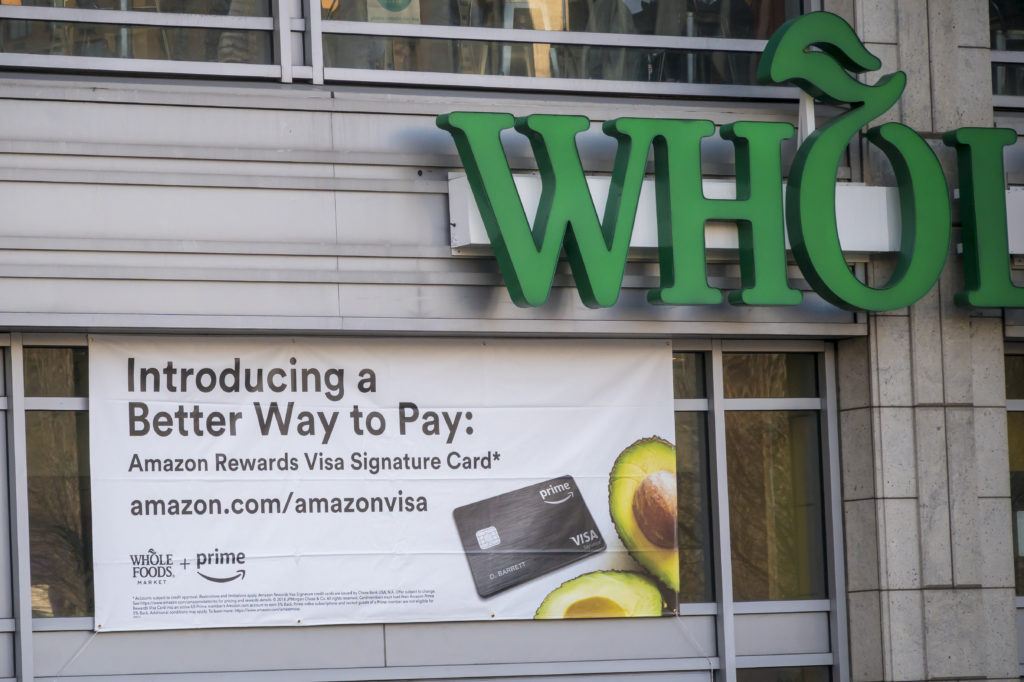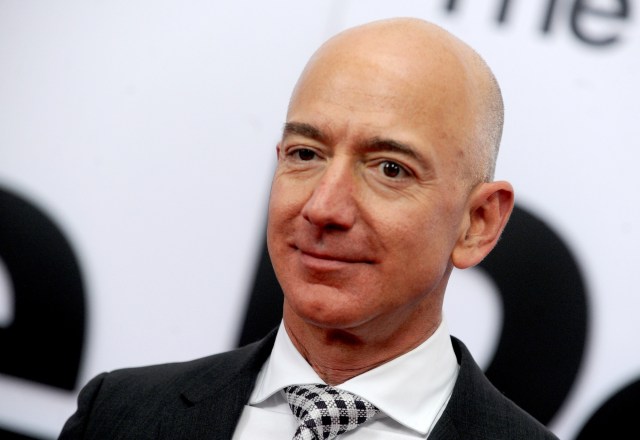Photo by Dennis Van Tine/ABACAPRESS.COM

On 28 August 2017, Amazon bought the high-end US supermarket chain Whole Foods Markets.
Jeff Bezos’ move astonished everyone. Amazon’s cut-throat, price-focused image was in stark contrast to Whole Foods’ organic, quality (and pricey) approach.
What was he after, and what’s he been up to?
Here’s your quick ten point (via press clippings) guide.
(1) The Bezos Empire
Jeff Bezos, world’s richest man, presides over a vast corporate empire, from book selling (where he started) to outer space (where he hasn’t been doing too well) to cloud storage (Amazon Web Services is the market leader and a huge driver of profit) to – the latest move – selling groceries. He also owns (personally) the Washington Post.
A wonderful chart on MarketWatch pulls it all together.
(2) Making money
Suddenly, Bezos became enormously more wealthy after the acquisition…
CNBC:
“Imagine being a tech company with so little profit that you could buy a grocery store and cut prices – all while improving your margin. Yes, that’s Amazon. In announcing … its $13.7 billion acquisition of Whole Foods on Thursday, Amazon also said that starting next week, it will offer lower prices on popular items…. Amazon’s operating margin for the second quarter was a paltry 1.7 percent. Whole Foods recorded operating profit of 4.8 percent.”
And also MarketWatch:
“Jeff Bezos is having some “fun” on Friday. The $34.39, or 3.6% surge in Amazon.com Inc.’s AMZN, -0.10% stock, after the deal to buy Whole Foods Market Inc. wfm is boosting the the Amazon co-founder and CEO’s coffers by about $2.75 billion.”
(3) Disrupting the food trade
“On the day Amazon announced plans to buy the upscale grocer for $13.7 billion, investors pulled billions of dollars from competing companies, with the market cap destruction totaling almost $40 billion for the 20 worst-performing food and retail stocks on the S&P alone. And the fallout from the potential merger isn’t over.
On Wednesday, meal-kit delivery company Blue Apron announced plans to slash the target share price for its upcoming I.P.O., from $15 to $17 per share to $10 to $11 per share—a dramatic cut for a company that, while unprofitable, was generating significant year-over-year revenue and closing its losses. The new share price would value Blue Apron at about $2 billion, compared to its previously expected $3.2 billion valuation.”
(4) Prime discount

“Prime customers carrying the Amazon Prime Rewards Visa Signature credit cards have a shiny new perk coming their way — the card will now net them the same 5 percent cash back at Whole Foods that it currently captures on Amazon.com.”
(5) Building Prime – and Amazon’s core business
CNBC:
“[Analyst] Nowak … estimated 38 percent of Whole Foods customers, or about 5 million households, are not Amazon Prime subscribers. We expect Amazon to convert half of these shoppers between now and the end of 2019,” he wrote. “We see AMZN’s Prime member growth and engagement, Echo device sales, and consumer web traffic/interest driving solid top line trends and GMV [gross merchandise volume] per customer growth.”
(6) Prices down
Whole Foods has been cutting (some) prices. Forbes:
“Morgan Stanley’s Brian Nowak wrote in a note to clients in August, as the acquisition was finalized, that Whole Foods’ average food-item price was approximately 14% higher than the average grocery store’s. He cited a recent survey in which 70% of consumers who said they didn’t shop at Whole Foods blamed pricing as the primary reason.”
But, as Bloomberg pointed out, “those price cuts were highly selective and carefully chosen for maximum attention”
(7) Prime Now food deliveries
…And, in select US cities, “free” if you can wait 2 hours….
“Amazon Prime Now…is operating out of Whole Foods in select cities where it offers rapid delivery in 1-2 hours, at cheaper prices than its competitors. Istacart, Amazon’s main competitor, charges $5.99 for 2-hour delivery, while Amazon charges $4.99, [if you want it in 1 hour] according to Business Insider.”
(8) Squeezing suppliers
“Yes, Whole Foods will now ask suppliers with annual sales of more than $300,000 to discount their wholesale price by 3 percent. (The Washington Post and Business Insider have reported three to five percent.)”
This was Amazon’s approach with publishers as it built its book business, and has been a standard Walmart technique.
(9) Revamping inventory
The new Amazon approach to shelf-stacking has caused problems. PJMedia:
“Employees are blaming tight controls on Whole Foods’ order-to-shelf (OTS) inventory system for the shortages. Employees acknowledge that less food is spoiling in storage rooms, but they describe OTS as a ‘militaristic’ system that crushes morale and leads to many items being out of stock,” the United Food and Commercial Workers tweeted.”
(10) Revamping management
And, related, reports The Daily Meal:
“We’ve lost team leaders, store team leaders, executive coordinators and even a regional vice president. Many of them have left because they consider OTS to be absurd. As an example, store team leaders are required to complete a 108-point checklist for OTS.”
“Amazon’s takeover of Whole Foods sent the stock of competing grocery chains plummeting. To understand why, you need to know something much simpler than Amazon’s far-reaching ambitions or possible vision for transformation of the grocery industry: Amazon doesn’t make any money.”
“Of course the nightmare scenario for the supermarket industry is that acquiring Whole Foods does allow Amazon to fundamentally crack the grocery home-delivery game in a way that leads Kroger to go the way of Borders. But the reason the takeover is such a disaster for the industry is that the financial implications are bleak even if Amazon doesn’t succeed in bringing incredible game-changing innovation to the sector. Introducing a player into the market that doesn’t care about profit margins is going to be devastating to competitors who have to.”










Join the discussion
Join like minded readers that support our journalism by becoming a paid subscriber
To join the discussion in the comments, become a paid subscriber.
Join like minded readers that support our journalism, read unlimited articles and enjoy other subscriber-only benefits.
Subscribe